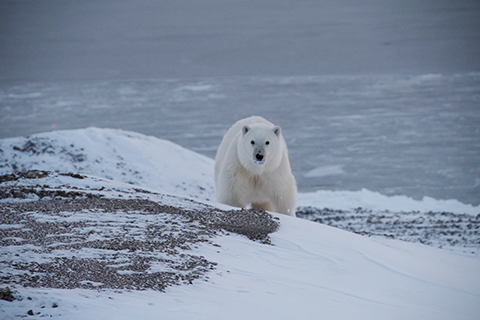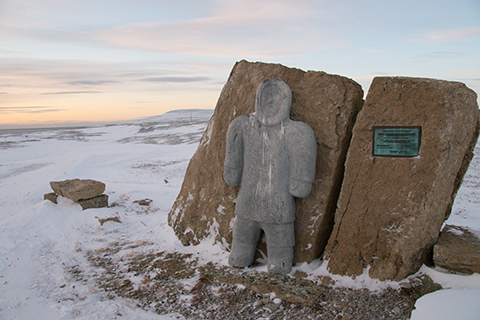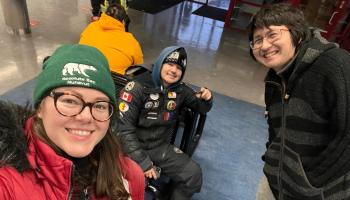Image Caption
Summary
Local Journalism Initiative Reporter
Windspeaker.com
When it comes to experiences as a journalist, APTN’s Danielle Paradis is quick to score her late October 2023 trip to the most remote northern communities in Canada as a 10.
“The Arctic is amazing. Farley Mowat used to talk about people having Arctic fever. So when you went up there, you just got a bug and you had a desire to go back. And that's me. I can't wait to go back. It was amazing. It's a unique place, but it's also, it's such a vibrant place. They are so connected to culture in a way that I found very inspiring,” said Paradis, whose new podcast The Place That Thaws ran its first episode this past Monday.
The six-episode series is what took Paradis and videojournalist Trevor Wright to Resolute Bay and Grise Fiord in Nunavut to delve “into the untold stories of resilience and adaptation in Canada’s northernmost communities,” according to the APTN news release.
The two communities were the focus of the 11-day trip, which included six days of travelling, highlighting the Tallurutiup Imanga national marine conservation area. The area was declared in 2019 by the federal government in consultation with the Qikiqtani Inuit Association. Scientists are predicting that by 2030 there will be no more summer ice in the Tallurutiup Imanga area.
“That was the jumping off point to those communities, but it's also the fact that the north is where we see climate change happening,” said Paradis.
The permafrost is melting. Animals are migrating farther north seeking colder temperatures as the weather warms up. There is coastal erosion.
“And you have two communities that were relocated by the federal government in the 1950s. So we have people who are there for Canada protecting Arctic sovereignty or helping to say ‘this is Canadian territory’ and that's a huge sacrifice,” said Paradis.
Inuit were relocated from northern Quebec above the Arctic Circle and transported to what is now Nunavut on promises not delivered on by the government, she says, including the promise that people could return to their homes.
“We have these communities who are very resilient. They have adapted, they live there and they're now…thriving in some of the communities. But it was also a high cost,” said Paradis.
Getting that far north involved “lots and lots of taking off and landing,” she says. The APTN team flew to Yellowknife, then to Iqaluit. They stayed overnight there before flying to the Arctic Bay. From there they flew to Rankin Inlet and then Resolute Bay. The flight from Resolute Bay to Grise Fiord was delayed because of weather conditions.
“This was a huge trip for me, but something that Inuit in the north are quite used to, especially if they're doing medical appointments. You're really at the mercy of nature,” said Paradis.
She didn’t know what to expect when she arrived but it certainly wasn’t that polar bears are an integral part of northern life.

“I was out with a 22-year-old dog sledder, Devon Manik, that'll be talked about in the next episode (March 4), and as he's chopping up frozen meat, he tells me to watch his back for polar bears and to keep a lookout for polar bears because they can just sneak up on you,” she said.
She heard plenty of polar bear stories, including how the RCMP and wildlife officers do patrols around the communities on Hallowe’en to ensure trick-or-treaters are safe from polar bears.
Paradis did take some photographs of the bears, but at a safe distance using a telephoto lens.
“It was in a truck. They're definitely aware of you. Half of the pictures I have, they're sniffing in the air, so probably trying to determine whether or not my colleague Trevor Wright and I are lunch,” she said with a laugh.
Paradis found the Nunavut communities were more like municipalities than First Nations reserves and although they had more autonomy over infrastructure, they still didn’t have sufficient funding to operate fully. While there were social problems, like alcoholism, drug overdoses weren’t as rampant as with communities in the south.
Along with climate change, Paradis also found cultural change. A hunting cabin “in the middle of nowhere” had access to the Internet. Grocery stores supplemented traditional hunting.
Community members were friendly and doors remained unlocked. Paradis relates in her podcast entering the home of the former mayor of Resolute Bay and not even knocking, something as a southerner she found “really uncomfortable… We don't even have a frame of reference for that. But when people knock, that far north, they think it's the cops.”
Paradis says she got a “mixed reaction” speaking to people about climate change.
“When it came to climate change that is a topic that not everybody feels comfortable talking about…I think we all have this concern, that we're not scientists. We're not going to be able to answer any scientific questions. But we focused a lot on lived experience and that's something that people can talk about pretty easily,” said Paradis.

But she points out that many Inuit are weary of environmentalists. While they were “too polite” to bring up Greenpeace’s campaign against the seal hunt in the mid-70s, Paradis said she believes it was still in their minds, as it was “quite damaging for people to be criticized for their way of life when they are living out on the land and, honestly, the most sustainable people out there.”
Paradis says she never got the feeling that people were worried about political ramifications about speaking their minds on climate change.
Episodes for The Place That Thaws will drop every Monday here: https://www.aptnnews.ca/ourstories/theplacethatthaws/
“When people listen, I hope they get a better sense of life in the north. I also want them to come away understanding that we need to make sure people in remote communities get the infrastructure they need to survive in these places,” said Paradis. “The podcast is very narrative focused. Even if you don’t care about climate change, I think you’ll get something out of it.”

